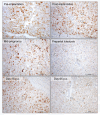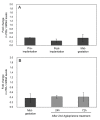Luteal and placental function in the bitch: spatio-temporal changes in prolactin receptor (PRLr) expression at dioestrus, pregnancy and normal and induced parturition
- PMID: 21812980
- PMCID: PMC3171325
- DOI: 10.1186/1477-7827-9-109
Luteal and placental function in the bitch: spatio-temporal changes in prolactin receptor (PRLr) expression at dioestrus, pregnancy and normal and induced parturition
Abstract
Background: Endocrine mechanisms governing canine reproductive function remain still obscure. Progesterone (P4) of luteal origin is required for maintenance of pregnancy. Corpora lutea (CL) are gonadotrop-independent during the first third of dioestrus; afterwards prolactin (PRL) is the primary luteotropic factor. Interestingly, the increasing PRL levels are accompanied by decreasing P4 concentrations, thus luteal regression/luteolysis occurs in spite of an increased availability of gonadotropic support. PRL acts through its receptor (PRLr), the expression of which has not yet been thoroughly investigated at the molecular and cellular level in the dog.
Methods: The expression of PRLr was assessed in CL of non-pregnant dogs during the course of dioestrus (days 5, 15, 25, 35, 45, 65 post ovulation; p.o.) as well as in CL, the utero/placental compartments (Ut/Pl) and interplacental free polar zones (interplacental sites) from pregnant dogs during the pre-implantation, post-implantation and mid-gestation period of pregnancy and during the normal and antigestagen-induced luteolysis. Expression of PRLr was tested by Real Time PCR, immunohistochemistry and in situ hybridization.
Results: In non-pregnant CL the PRLr expression was significantly upregulated at day 15 p.o. and decreased significantly afterwards, towards the end of dioestrus. CL of pregnancy showed elevated PRLr expression until mid gestation while prepartal downregulation was observed. Interestingly, placental but not interplacental expression of PRLr was strongly time-related; a significant upregulation was observed towards mid-gestation. Within the CL PRLr was localized to the luteal cells; in the Ut/Pl it was localized to the fetal trophoblast and epithelial cells of glandular chambers. Moreover, in mid-pregnant animals treated with an antigestagen, both the luteal and placental, but not the uterine PRLr were significantly downregulated.
Conclusions: The data presented suggest that the luteal provision of P4 in both pregnant and non-pregnant dogs may be regulated at the PRLr level. Furthermore, a role of PRL not only in maintaining the canine CL function but also in regulating the placental function is strongly suggested. A possible functional interrelationship between luteal P4 and placental and luteal PRLr expression also with respect to the prepartal luteolysis is implied.
Figures






Similar articles
-
Endocrine and molecular control of luteal and placental function in dogs: a review.Reprod Domest Anim. 2012 Dec;47 Suppl 6:19-24. doi: 10.1111/rda.12036. Reprod Domest Anim. 2012. PMID: 23279458 Review.
-
Expression and localization of vascular endothelial growth factor A (VEGFA) and its two receptors (VEGFR1/FLT1 and VEGFR2/FLK1/KDR) in the canine corpus luteum and utero-placental compartments during pregnancy and at normal and induced parturition.Gen Comp Endocrinol. 2015 Nov 1;223:54-65. doi: 10.1016/j.ygcen.2015.09.020. Epub 2015 Sep 26. Gen Comp Endocrinol. 2015. PMID: 26414127
-
Time related changes in luteal prostaglandin synthesis and steroidogenic capacity during pregnancy, normal and antiprogestin induced luteolysis in the bitch.Anim Reprod Sci. 2009 Nov;116(1-2):129-38. doi: 10.1016/j.anireprosci.2008.12.011. Epub 2008 Dec 24. Anim Reprod Sci. 2009. PMID: 19162415
-
Transcriptome analysis reveals differences in mechanisms regulating cessation of luteal function in pregnant and non-pregnant dogs.BMC Genomics. 2017 Sep 27;18(1):757. doi: 10.1186/s12864-017-4084-9. BMC Genomics. 2017. PMID: 28954628 Free PMC article.
-
Luteal regression vs. prepartum luteolysis: regulatory mechanisms governing canine corpus luteum function.Reprod Biol. 2014 Apr;14(2):89-102. doi: 10.1016/j.repbio.2013.11.004. Epub 2013 Dec 21. Reprod Biol. 2014. PMID: 24856467 Review.
Cited by
-
Expression of prolactin receptors in normal canine mammary tissue, canine mammary adenomas and mammary adenocarcinomas.BMC Vet Res. 2012 May 30;8:72. doi: 10.1186/1746-6148-8-72. BMC Vet Res. 2012. PMID: 22647582 Free PMC article.
-
Canine Endotheliochorial Placenta: Morpho-Functional Aspects.Adv Anat Embryol Cell Biol. 2021;234:155-179. doi: 10.1007/978-3-030-77360-1_8. Adv Anat Embryol Cell Biol. 2021. PMID: 34694481
-
Implications of the RhoA/Rho associated kinase pathway and leptin in primary uterine inertia in the dog.J Reprod Dev. 2021 Jun 21;67(3):207-215. doi: 10.1262/jrd.2020-141. Epub 2021 Mar 21. J Reprod Dev. 2021. PMID: 33746146 Free PMC article.
-
Leptin in the canine uterus and placenta: possible implications in pregnancy.Reprod Biol Endocrinol. 2015 Mar 8;13:13. doi: 10.1186/s12958-015-0003-6. Reprod Biol Endocrinol. 2015. PMID: 25871422 Free PMC article.
-
Interplacental uterine expression of genes involved in prostaglandin synthesis during canine pregnancy and at induced prepartum luteolysis/abortion.Reprod Biol Endocrinol. 2014 May 30;12:46. doi: 10.1186/1477-7827-12-46. Reprod Biol Endocrinol. 2014. PMID: 24884887 Free PMC article.
References
-
- Concannon PW, McCann JP, Temple M. Biology and endocrinology of ovulation, pregnancy and parturition in the dog. J Reprod Fertil Suppl. 1989;39:3–25. - PubMed
-
- Nohr B, Hoffmann B, Steinetz BE. Investigation of the endocrine control of parturition in the dog by application of an antigestagen. J Reprod Fertil Suppl. 1993;47:542–543. - PubMed
-
- Concannon PW. Biology of gonadotrophin secretion in adult and prepubertal female dogs. J Reprod Fertil Suppl. 1993;47:3–27. - PubMed
Publication types
MeSH terms
Substances
LinkOut - more resources
Full Text Sources

